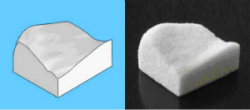We’ve grown accustomed to the idea that 3D printing holds great promise for advances in the field of medicine. However, each individual advance is still thrilling as it promises even greater future discoveries await. From orthotics to organs, a flurry of research activity brings news from the frontiers of modern medicine and has quickened the pace of discoveries that previously would have been decades apart.
One of the latest developments at the crossroads of 3D technology and human health is in the area of joint replacement. Currently, there are only a very limited number of ways to address the issue of joint pain, with joint replacement surgery being used only as a desperate last measure. With arthritis and joint pain being a very common cause of disability in North America, it has become clear that this is an area that requires more significant attention.
Artificial joints have been traditionally made with a variety of plastics and metals, materials that are very clearly alien to the human body. In addition to the foreign nature of their components, the materials themselves break down after 10 to 20 years of use and the joint can become non-functional even sooner. In other words, artificial joints as currently produced do not provide a viable long-term solution for those suffering from joint disorders.
In keeping with the large population impacted by joint pain, doctors Rita Kandel, Marc Grynpas, and Andras Nagy at Mount Sinai’s Samuel Lunenfeld Research Institute began working with bioengineers, bone biologists, surgeons, and stem cell biologists in an effort to study the possibilities for using a patient’s own tissues to create new bones. As an outgrowth of this interest, Dr. Kandel began working with Doctors Pilliar and Toyserkani from the Universities of Toronto and Waterloo to examine 3D printing as an avenue for joint creation. Dr. Kandel explained the nature of this interdisciplinary collaboration:
“This is a real meeting of minds. Dr. Toyserkani uses 3D printing to literally construct the joint using biodegradable material. We then take that joint and use the patient’s stem cells to grow actual tissue (cartilage, etc.) on it. The original damaged joint will be replaced by a joint made entirely of the patient’s own tissues. It’s quite extraordinary.”
The 3D printing process begins with the taking of X-rays of the patient’s damaged joint. The data gathered in the X-rays in converted into a 3 dimensional computer model that can be sent directly to the printer. The porous material deposited by the printer reconstructs an exact replica of the bone shape required for the artificial joint. The material with which it is printed can support cell growth and is integrated with the adjoining cartilage. As the bone grows through the material, it takes its shape and the substitute degrades – leaving only the patient’s own bone as their replacement joint. Dr. Kandel described the process and its benefits:
“The joint is a very complex structure of specific shapes and all components have to work together to create the painless movement we experience when we move our knees and elbows. Now, with 3D printing, we can tailor precisely the implant to the missing structure in a patient’s body. This work is a shining example of personalized medicine, because the tissues that comprise these joints are those of the exact patient who will receive the replacement.”
These treatments are not yet available as methods for addressing cases in which patients need joint replacement surgeries. A great deal of study and evaluation must be undertaken in order to prepare the procedure for its first phase of clinical trials. The team anticipates that the procedure will be ready for testing in human patients in the next several years. The research team is very optimistic about the future of 3D printing in the creation of artificial joints:
“Metal and plastic doesn’t belong in the body and cannot repair itself. By generating a biological implant using the individual’s own cells, it will reconstruct a normal, native joint surface…I believe it’s the way of the future.”
What do you think? Will this be the future of joint replacement surgery? Let’s hear your opinion in the 3D printed joint forum thread on 3DPB.com.
Subscribe to Our Email Newsletter
Stay up-to-date on all the latest news from the 3D printing industry and receive information and offers from third party vendors.
You May Also Like
Precision at the Microscale: UK Researchers Advance Medical Devices with BMF’s 3D Printing Tech
University of Nottingham researchers are using Boston Micro Fabrication‘s (BMF) 3D printing technology to develop medical devices that improve compatibility with human tissue. Funded by a UK grant, this project...
3D Printing Webinar and Event Roundup: April 21, 2024
It’s another busy week of webinars and events, starting with Hannover Messe in Germany and continuing with Metalcasting Congress, Chinaplas, TechBlick’s Innovation Festival, and more. Stratasys continues its advanced training...
3D Printing Webinar and Event Roundup: March 17, 2024
It’s another busy week of webinars and events, including SALMED 2024 and AM Forum in Berlin. Stratasys continues its in-person training and is offering two webinars, ASTM is holding a...
3D Printed Micro Antenna is 15% Smaller and 6X Lighter
Horizon Microtechnologies has achieved success in creating a high-frequency D-Band horn antenna through micro 3D printing. However, this achievement did not rely solely on 3D printing; it involved a combination...

































